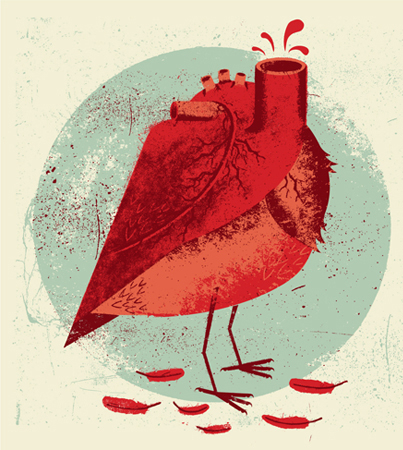As of this week, on Twitter you can no longer “favorite” tweets. Instead, you “like” them, a change in language that is visually represented by a move away from the little clickable star icon at the bottom of a tweet to a little heart that turns bright red if you click it.
As with any change on Twitter, this one is causing a major uproar across the social network. And indeed, there are a lot of reasons to be upset, even for casual users of the platform — but even more so when thinking about Twitter’s affordances for activists.

Here is what Twitter has to say about the change: “The heart […] is a universal symbol that resonates across languages, cultures, and time zones. The heart is more expressive [than the star], enabling you to convey a range of emotions and easily connect with people.”
A range of emotions? I don’t know about you, but a heart to me seems a lot more specific in terms of its emotional range than a star. Resonating across languages and cultures? How about the intense gendering of a red heart in a lot of cultures?
And yes, it might be great to use the heart to connect with people (although in which way easier than with the old star, I do not know). But just how useful is a heart in organizing people around topics a little more serious than sports teams or vacation spots? Topics like, say, police brutality (“I totally HEART this article about 95 people being killed by cops just this October”).
In the Middle East context, this sucks given the gender connotations of that big red blinking heart. https://t.co/ik7t69NVAY
— zeynep tufekci (@zeynep) November 5, 2015
But I digress. What I meant to do in this post, in true Twitter spirit, is collect and sum up some of the discussions that have been revolving around hearts and stars these days:
- NPR has a brief piece that refutes Twitter’s claim that “in our tests, we found that people loved it.” The conclusion is disappointing, though: people hate hearts because they hate change; they will love them eventually because we love what we are used to. Come on NPR, you can do better than that.
- Robinson Meyer, writing for The Atlantic, connects the Twitter heart-over to the company’s recent appalling quarterly earnings report and failure to attract investors.
- The Guardian’s Osman Faruqi takes a similar angle, but uses #heartgate as an argument for nationalizing Twitter as a public communication infrastructure.
- Dan Gillmor of Slate drives home the point that Twitter is changing from a user-defined network to one where “you and I aren’t much more than pawns in the operations of the giant, centralized enterprises that we use every day to communicate.”
https://twitter.com/wfederman/status/661903976028336128
- In this Paste Magazine article, Shane Ryan focuses on the interpersonal awkwardness arising from the heart button, such as increased creep potential and having no way of elegantly ending conversations with “weirdos.”
- Unfortunately, the change seems to invite a surge of homophobic reactions.
- Here is an informative piece from Fortune, in which Mathew Ingram takes the perspective of Twitter’s core users and details the versatile ways in which the old “favorite” option was used that are frustrated by the new “like.”
- Tressie McMillan Cottom strikes a similar chord, listing all the ways she uses the favorite star (e.g. the “you so shady” fave) and summarizing: “Hearts box you in on Twitter. Stars set you free.”
- Messy Thinking has another list of “fave as…”, but ends with a personal defense of the new heart button
Really loving the new US Flag design. Thanks, @twitter!#TwitterHeart pic.twitter.com/Zm7c6FvPaf
— Reid Parker (@ReidParker_) November 3, 2015
- Continuations takes a cross-platform design perspective, comparing the homogenization of features on Twitter and other social networks with the increasing exchangeability of different car brands and citing economic principles behind these developments. This is interesting to think about since a lot of the core Twitter features (like the hashtag or retweeting) were NOT designed by the corporation but developed bottom-up by core users.
- Aside from hitting the reader with a battery of puns on the heart/star theme, Collin Brooke argues that the former allowed productive ambiguities that were part of what distinguished Twitter from other platforms. With the change of/to heart, he sees Twitter (the company) attempting to be more like other social networking services, and losing its distinct profile in the process.
- Jack Smith at Tech.Mic discusses affect and how the new like button speaks to Twitter’s need to be “a happy place.” This contrasts with the level of abuse members of marginalized groups have faced on the platform.
This feels like a slippery slope to love and happiness on the internet. #heart #twitterheart
— Sarah Phillips (@sarahtacp) November 3, 2015
- Kate Bowles does a great job explaining how Twitter’s claims about the “universal” appeal of the heart icon are really just poorly disguised attempts at streamlining user experience.
- This piece at Hopes&Fears brings in a variety of academic’s voices with differing views on hearts, stars, and the design-user interface.
- Maha Bali taps into her own Twitter network and synthesizes tweoples’ reactions to the new heart attack.
- Of course, Twitter itself is brimming with commentary under the hashtag #TwitterHeart.
- Some tech savvy people have taken to creative hacks around the heart icon.
In very few of these articles is any mention made to activist use of Twitter and the platform’s potential of making unpleasant things visible, a potential that grinds against Hello-Kitty-esque sparkling hearts. But some of the more active and engaged users were quicker to pick up on the implications:
https://twitter.com/siddhmi/status/662316859149197312
maybe the heart is their way of saying "stop it"
tweets about police brutality.
do you like that? do you really??
thought so. #NoConvo
— Jade E. Davis (@jadedid) November 4, 2015


